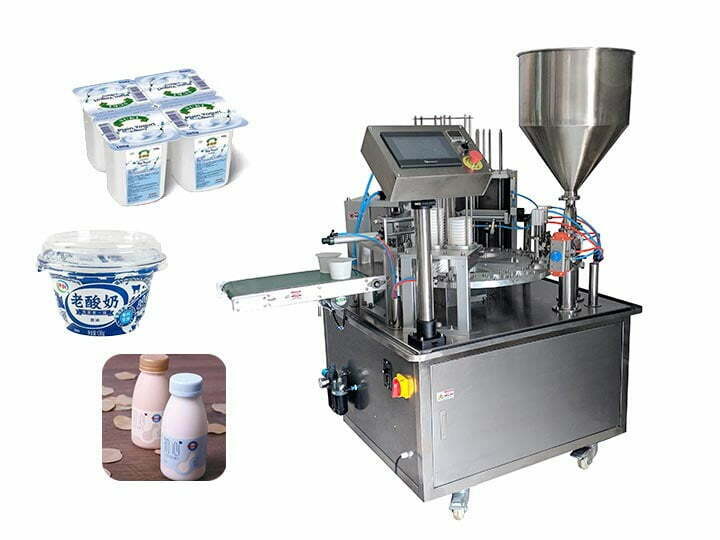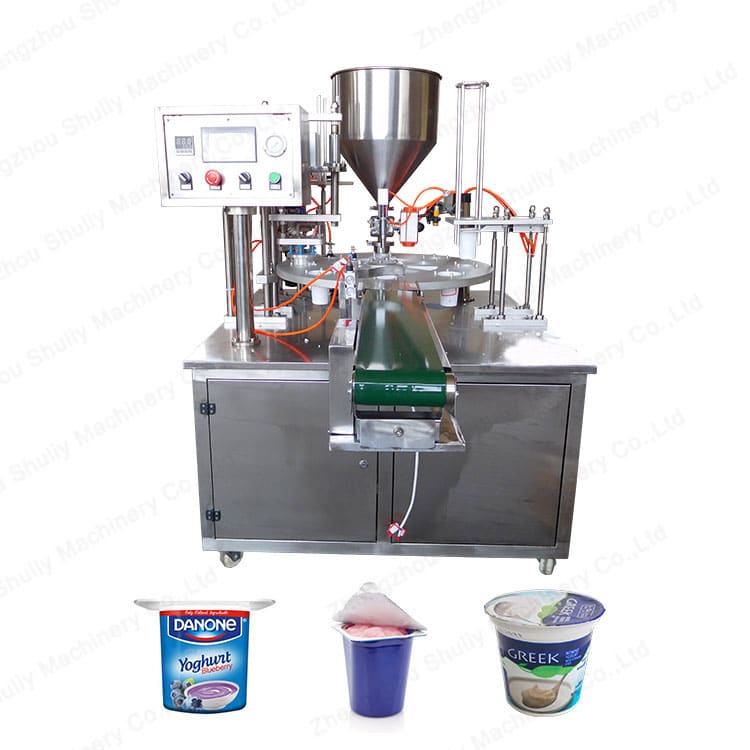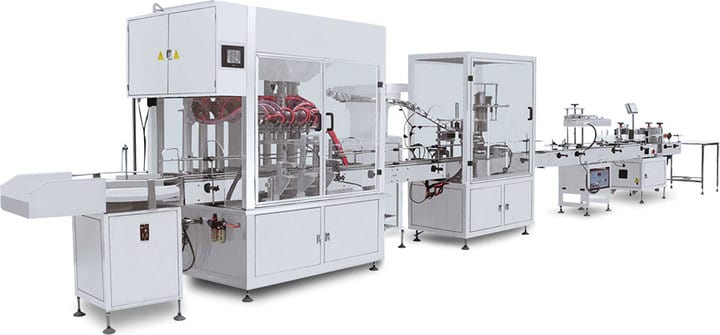There are more and more varieties of dairy products, and the organizational structure and composition of each type are not the same. Therefore, for different varieties, different packaging methods of yogurt need to be selected to maintain their taste. The following briefly introduces the packaging methods of several dairy products:
Packaging methods of yogurt
Yogurt is a milk product obtained by fermenting fresh milk or milk powder through lactic acid bacteria at a temperature of 40°C-45°C until the pH value of the fermented product reaches 3.5-5.0, and then refrigerating to terminate the fermentation. This kind of food is delicious and nutritious, and long-term drinking helps digestion and invigorates the stomach. Various sweeteners, stabilizers, fruit juices, or other aromatic flavoring agents can be added before packaging to make yogurt with different flavors. With the advancement of packaging methods and equipment and the continuous emergence of new packaging materials, there are more and more types of yogurt products, and some products are very different in technology and packaging materials.
Fermented yogurt
Fermented yogurt refers to adding sucrose or sweetener to the raw milk, then sterilizing, then inoculating the cultured lactic acid bacteria strains into the raw milk, fermenting for 2 hours at a temperature of 40 ℃ ~ 45 ℃, so that the pH value reaches 3.5-5.0, and then put it in the cold storage and ferment the product. This is the most traditional yogurt product; it has been popular for many years and is deeply loved by people. However, the storage and sale of this yogurt must be carried out under refrigerated conditions, otherwise, the lactic acid bacteria in the yogurt will continue to grow, easily infected with mold or decomposed into other products.
The packaging of fermented yogurt mainly includes glass bottles, porcelain bottles, plastic composite films, and plastic cups. Glass bottles and porcelain bottles are usually wrapped and sealed with wax paper, which is easy to operate. However, due to problems such as high quality, easy damage, difficulty to recycle, and difficulty to clean, some manufacturers use double-layer composite films and plastic cups to package yogurt to overcome the above problems. But it still needs to be sold and stored at low temperature, and the shelf life is only 7 days at 4°C.

Packaging methods of sterilized fermented yogurt
In order to solve the storage problem of fermented yogurt, people have developed sterilized fermented yogurt. For fermented yogurt, add a certain amount of fermented yogurt to stabilize the consistency of the strong yogurt; then homogenize, canned the homogenized product, pressurize it, and finally refrigerate at 4℃-6℃24 A kind of sterilized yogurt made in hours. The consistency and taste of this product are not only better than ordinary yogurt but also do not need to be stored frozen. It can be stored for 6 months at a normal temperature without bacteria or other degradation.
The packaging materials of sterilized fermented yogurt must be able to withstand high temperatures and have good barrier properties. Most sterilized and fermented yogurts are packaged in composite film bags, which are divided into two types: square bags and pillow bags. In recent years, white plastic polystyrene plastic cups made by thermoforming and stretching have been used to hold fermented yogurt, and they are sealed with aluminum foil composite materials by high-frequency heat sealing. This kind of packaging decoration is exquisitely designed, air-tight, and leak-proof after heat sealing.
Acidified milk beverage
Using skimmed milk as the raw material can produce a variety of acidified milk beverages. It is generally drinkable with water or carbonated water before drinking, and it is best to drink immediately after dilution. If it is stored for too long after dilution, it will Milk protein precipitation occurred. After fermenting with skimmed milk, adding sugar, water, and spices, and then homogenizing under high pressure, the acidified milk beverage made by ultra-high temperature instantaneous sterilization is not only suitable for consistency and delicious but it can be drunk directly without adding water and carbonated water when drinking. In addition, the protein in this beverage milk is evenly dispersed and has a long shelf life. Acidified milk beverage is a product that has only appeared in recent years, so it’s packaging mainly includes composite flexible packaging bags, plastic cups sealed with aluminum foil or aluminum foil composite materials, and composite cartons. The composite materials used in the composite flexible packaging bag include PT/PVDC/PE, BOPP/PVDC/PE, NY/PVDC/PE, and composite aluminum foil, etc.; the plastic cup is a polystyrene cup made of white plastic by thermoforming and stretching. It is sealed by high-frequency heat sealing with aluminum foil composite material; the material of the composite carton is plastic-coated paperboard, mainly polyethylene/polyethylene three-layer composite paperboard.
Packaging methods of blending yogurt drinks
Blending yogurt beverages refers to directly adding water, sweeteners, sour agents, stabilizers, and flavoring agents to raw milk or skimmed milk powder without fermentation, some products also add vitamin A or vitamin D, and some products add calcium The prepared slurry should be homogenized under high pressure, canned and sealed, and then subjected to ultra-high temperature instantaneous sterilization treatment, and finally cooled to make the product. This kind of product has reasonable nutrition blending, good taste, and long shelf life, and is deeply loved by consumers, especially by children and teenagers.
The packaging of the blended yogurt beverage is the same as the packaging of the acidified beverage, and also includes three types of composite flexible packaging bags, plastic cups (bottles), and composite cartons.

Cream and margarine
The manufacturing process of cream is relatively simple, that is, the cream obtained by centrifugal separation is neutralized by adding lime milk or sodium carbonate to keep the pH value at about 6.4 to 6.8, then sterilizing and cooling. Stay at a low temperature of 2°C-10°C for a certain period of time to promote the post-cooking of the cream, then stir, and finally make it through processes such as pressing. The fat content of butter and margarine is very high, which can reach about 80%-83%, and the moisture content is less than 16%, so it is easy to oxidize and deteriorate, and it is easy to absorb the peculiar smell in the surrounding environment. Therefore, the main requirements of packaging materials are excellent gas barrier properties, oxygen impermeability, aroma impermeability, and odorless ness.
Cream and margarine are traditionally packaged in glass bottles and polyethylene containers, and sealed with AL/PE composite materials. General packaging methods of yogurt can be wrapped with parchment paper, greaseproof paper, aluminum foil/sulfuric acid paper, or aluminum foil/oilproof paper composite materials. Boxed butter and margarine are generally packaged in small boxes made of plastic-coated cardboard or aluminum and foil composite materials. Various plastic boxes that are popular recently are made of PVC, PS, ABS, and other sheets through thermoforming processes, and some are packaged in co-extruded plastic boxes and paper/plastic composite boxes. The lid of the box is generally made of PVC plastic, and a layer of paper can be added to decorate the box.
Packaging methods of cottage cheese
Cheese is a dairy product made by coagulating raw milk with rennet or pepsin, and then processing, forming, and fermenting the clot to mature. Cheese has a high nutritional value, which is rich in protein, fat, calcium, phosphorus, sulfur, and other salts, as well as a variety of vitamins, and has a high digestion and absorption rate.
Whether it is fresh cheese or processed cheese, it must be airtightly packaged. The preservation of cheese is mainly to prevent mold and rancidity, followed by keeping moisture to maintain its flexible tissue and avoid weight loss. The cheese is packaged in a molten state, evacuated, and filled with nitrogen, so that it can be stored for a long time, but this requires the packaging material to be able to withstand high temperatures so as not to soften and deform when the molten mash is injected. Polypropylene has a good heat resistance and can maintain its strength above 120°C. The rigid box made of polypropylene sheet is suitable for melt filling of cheese.
The single-layer plastic film has poor permeability, is easy to breathe, oxygen, and is not heat-resistant. It is easy to break and cause product pollution. Cheese packaged in single-layer film can only be stored for a short time, but its price is cheap. Commonly used are PE, PVC, PVDC, E-VA, NY, etc. Heat shrink packaging is often used to eliminate oxygen in the bag.
The flexible packaging method of fresh cheese and cheese should use composite materials. Commonly used are PT/PVDC/PE, PET?PE, BOPP/PVDC/PE, NY/PVDC/PE, composite aluminum foil and plastic-coated paper products, and vacuum packaging is mostly used.
Condensed milk
Condensed milk is divided into two types: sweetened condensed milk and unrefined milk. The production process of the two is not the same. In the former, sucrose is added to the processed raw milk, then preheated for sterilization, vacuum concentration, and can be sealed directly after cooling; in the latter, the raw milk is directly preheated, sterilized, vacuum concentrated, and homogenized without adding sucrose. After cooling, the cans are filled and sealed, and then sterilized and shaken for a second time, and finally, the finished product is obtained.
The content of sucrose in the sweetened condensed milk product is 40%-45%, and the osmotic pressure is increased after the sugar is added, and the finished product is endowed with preservability. Sweetened condensed milk is mostly used as a raw material for beverage and food processing. Condensed milk is sterilized by high temperatures, and vitamin B1 is lost. The other ingredients are kept good. The nutritional value is almost the same as that of fresh milk. After high-temperature treatment, it becomes soft curd milk, which is coagulated by stomach acid or rennet in the human body. Extremely soft and easy to digest. In addition, the fat is homogenized to make the fat globules finer and easier to absorb. It is mostly used for feeding babies and can also be used as a beverage for brewing coffee or black tea.
The storage of condensed milk is mainly to prevent the contamination of common microorganisms such as mold; therefore, in addition to selecting suitable packaging materials, the residual air in the packaging container should also be removed and vacuum sealed. At present, metal cans are mainly used for packaging. The filling room and containers should be strictly disinfected. It is best to use an automatic filling machine for filling and sealing with a vacuum sealing machine to remove the air in the head gap as much as possible. The storage temperature of sweetened condensed milk should not be higher than 15°C. After ultra-high temperature instantaneous sterilization, evaporated milk can be stored at room temperature. The shelf life is about 1 year.
